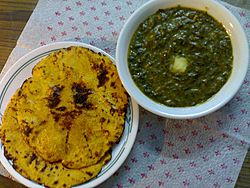Sarson ka saag facts for kids

Makki ki roti with Sarson ka saag
|
|
| Course | Main course |
|---|---|
| Place of origin | North India region of the Indian subcontinent |
| Associated national cuisine | India |
| Main ingredients | Mustard leaves |
Sarson ka saag is a very popular vegetarian dish from the northern part of the Indian subcontinent. It is known as Sarson ka saag in Urdu and Haryanvi. In Punjabi, it is called Sarson da saag, and in Dogri, it's Sareyan Da Saag. This tasty dish is made from mustard greens and spices like ginger and garlic. It is often served with a special type of bread called Makki ki roti.
Sarson ka saag and Makki ki roti are strongly connected to regions like Jammu, Himachal Pradesh, Haryana, and Punjab. It is seen as a special meal across all of North India. People especially enjoy eating it during the cold winter months.
What is Sarson ka Saag?
Sarson ka saag is a creamy, flavorful dish made mainly from fresh mustard greens. These greens are cooked down slowly with various spices. Common spices include ginger, garlic, and green chilies. Sometimes, other leafy greens like spinach (Palak) are added. This can make the dish thicker and give it a brighter green color.
The word "saag" generally refers to any dish made from leafy green vegetables. Sarson ka saag is one of the most famous types of saag. It is known for its unique, slightly bitter taste from the mustard greens.
Where Does the Name Come From?
The name Sarson Ka Saag tells you exactly what the dish is. Sarson means "mustard." The word Sarson comes from the old Sanskrit word Sarśapa, which also means mustard.
The word Saag means "greens" or "leafy vegetable." It comes from the Sanskrit word Śāka (pronounced Shaak). So, Sarson Ka Saag simply means "mustard leafy vegetable preparation." The Dogri word Sareyan also comes from the same Sanskrit root as Sarson.
How Do People Eat It?
Sarson ka saag is a traditional dish. It is usually served with Makki ki roti, which is a flatbread made from corn flour. Sometimes, it is eaten with Bajra ki roti (millet bread) or even regular wheat roti.
To make it even more delicious, people often top the hot saag with a dollop of makkhan (homemade butter). Even more traditionally, it is served with ghee (clarified butter). The rich butter or ghee melts into the warm saag, adding a creamy texture and flavor.
Mustard greens grow best in winter and spring. Because they are very common in North India, Sarson ka saag has become a favorite dish there. Mustard has been grown in India for thousands of years, making this dish a long-standing tradition.
See also
 In Spanish: Sarson da saag para niños
In Spanish: Sarson da saag para niños

